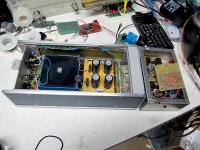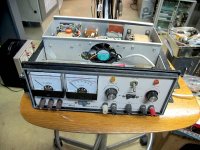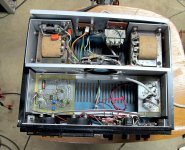Flames heat a larger area quicker. Anyone with half a brain will do this outside...
I got one of these maybe 30 years ago when they were less than $50. There is a catalytic converter attachment that you light with flame to preheat, then extinguish. It will produce enough heat in a small space for surgically removing SMD parts without too much mess.....still best done outside. I got mine for removing epoxy from potted boards. It does a fair job of that too.
Amazon.com: Weller WSTA3 Pyropen Professional Cordless Butane Soldering Iron: Home Improvement
...Sanyo STK392-110.... any use in audio...?
They "are" audio amplifiers withOUT idle bias. I predict significant crossover distortion on small signals.
What you want is the -010 part which does have output stage bias. However I suspect for ordinary TV use, most makers will/did settle for the cheaper part.
It also is not clear what gain it is stable at, since it really is not intended for voltage feedback. And I have a feeling it is good for more V and A than power; maybe no-matter for TV correction but may overheat in audio. Also complete lack of protection from shorts-- supposed to be nailed to its load, not brought out to screws for easy user screw-up.
Attachments
Actually the AB part does not show emitter resistors. Maybe they trust the matching to the Vbe multiplier, or maybe just "simplified".
It occurs to me that *two* focus channels, outputs linked with part-Ohm resistors, and offset voltages in the inputs, would get the pure-B part into AB. But now you get just one audio channel per whole module. Does help with power dissipation.
With just four stages of current gain (and no other fancy tricks) it is unlikely to be real low THD.
LM3886 are far better audio amplifiers and still available.
It occurs to me that *two* focus channels, outputs linked with part-Ohm resistors, and offset voltages in the inputs, would get the pure-B part into AB. But now you get just one audio channel per whole module. Does help with power dissipation.
With just four stages of current gain (and no other fancy tricks) it is unlikely to be real low THD.
LM3886 are far better audio amplifiers and still available.
Thanks! Yes, I've seen the lack of emitter resistors and bias circuitries for the power devices. So I'll better scrap these hybrids, 'cause I'm really not too eager to build a colour TV.
Best regards!
The vertical deflection of CRT TV/monitor uses parts that could be used for audio if it was a discrete class AB implementation. Think complementary driver transistor pair suitable for audio amps. The CRT driver board if it was discrete will employ transistors suitable for Vas stage, on a color you will get 3 pieces. The horizontal driver transistor can be a source of Vas transistors too.
The vertical deflection of CRT TV/monitor uses parts that could be used for audio
This was true all the way back to tube TV days. In the 60's I discovered that one could simply break the feedback loop and wire in a guitar pickup or ceramic phono cartridge, connect a speaker where the yoke goes (green and black wires) and have an instant amplifier. The entire vertical sweep circuit was a class A SE audio amplifier optimized for a single frequency, 60 Hz in the USA. Depending on the size of the TV it would make from 2 to about 8 watts.
The original Bottlehead "SEX" amplifier did exactly that in the early 2000's, right down to the 6DN7 tube and the vertical sweep OPT. The vertical section of a TV set had to have good linearity, otherwise round things wouldn't be round.
The RGB gun driver chips and transistors can be quite useful as general amplifiers. You just look up the data sheet and from that you can work out how to make the black level circuit so that it can be converted into a mute line to be driven from a remote control.
They are npn only, in most cases
...tube TV days. ... The entire vertical sweep circuit was a class A SE audio amplifier optimized for a single frequency, 60 Hz ...
Actually a ramp-wave with harmonics out toward 6KHz. Anyway costs no more to get KHz out of a small "60Hz" transformer.
They are npn only, in most cases
In VGA screens they were often push pull with 3 each PNP/NPN.
I wouldn't bother and just buy new.
It takes time to remove the old components and then there's no guarantee you wont damage them removing them.
Old trimmers and pots just want binning anyway.
Same for relays and switches.
Used components are more trouble than they are worth.
It takes time to remove the old components and then there's no guarantee you wont damage them removing them.
Old trimmers and pots just want binning anyway.
Same for relays and switches.
Used components are more trouble than they are worth.
I wouldn't bother and just buy new.
It takes time to remove the old components and then there's no guarantee you wont damage them removing them.
Old trimmers and pots just want binning anyway.
Same for relays and switches.
Used components are more trouble than they are worth.
There are personal and financial reason for scavenging parts. It is also educational. I've been there. The notion that desoldering a part will damage it is so naive.
Monitors and TVs are bound to use genuine parts which is an added bonus. This activity is great for experimenting and reduction of waste. The parts won't be used on mission critical or medical applications, this is a hobby.
As with any hobby, an a decent supply of materials will often keep things moving along where you would have been forced to stop without. And even if the parts are questionable, they will have often served a purpose on a temporary basis until the preferred part is available.
I like to make sure that nearly every electric device that is headed out passes through the shop first. I pulled a nice 5uf polypropylene cap from a microwave that has served me well helping with a noise from my car alternator, just one example anyways.
What would be nice to see, now that radio shack has vaporized, is our local appliance recycling venture maintaining a supply of parts pulled from the various devices that pass through there.
I would probably be the only customer however...
I like to make sure that nearly every electric device that is headed out passes through the shop first. I pulled a nice 5uf polypropylene cap from a microwave that has served me well helping with a noise from my car alternator, just one example anyways.
What would be nice to see, now that radio shack has vaporized, is our local appliance recycling venture maintaining a supply of parts pulled from the various devices that pass through there.
I would probably be the only customer however...
Did it really? Isn't RS Components its' successor?...now that radio shack has vaporized...
Best regards!
Radio Shack was a popular retail electronics chain here in the USA for decades, used to have a lot of components years ago, but faded into a cell phone store, and then gone. They had consumer level equipment as well, speakers and stereo systems.
Just had a look through an old Practical Electronics magazine.
Lots of small electronic component sellers advertising.
Now all gone.
- Status
- This old topic is closed. If you want to reopen this topic, contact a moderator using the "Report Post" button.
- Home
- Design & Build
- Parts
- Parts and components salvaging



